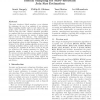Free Online Productivity Tools
i2Speak
i2Symbol
i2OCR
iTex2Img
iWeb2Print
iWeb2Shot
i2Type
iPdf2Split
iPdf2Merge
i2Bopomofo
i2Arabic
i2Style
i2Image
i2PDF
iLatex2Rtf
Sci2ools
SIGMOD
1996
ACM
1996
ACM
Bifocal Sampling for Skew-Resistant Join Size Estimation
This paper introduces bifocal sampling, a new technique for estimating the size of an equi-join of two relations. Bifocal sampling classi es tuples in each relation into two groups, sparse and dense, based on the number of tuples with the same join value. Distinct estimation procedures are employed that focus on various combinations for joining tuples (e.g., for estimating the number of joining tuples that are dense in both relations). This combination of estimation procedures overcomes some well-known problems in previous schemes, enabling good estimates with no a priori knowledge about the data distribution. The estimate obtained by the bifocal sampling algorithm is proven to lie with high probability within a small constant factor of the actual join size, regardless of the skew, as long as the join size is (n lgn), for relations consisting of n tuples. The algorithm requires a sample of size at most O( pn lg n). By contrast, previous algorithms using a sample of similar size may re...
Related Content
| Added | 08 Aug 2010 |
| Updated | 08 Aug 2010 |
| Type | Conference |
| Year | 1996 |
| Where | SIGMOD |
| Authors | Sumit Ganguly, Phillip B. Gibbons, Yossi Matias, Abraham Silberschatz |
Comments (0)

